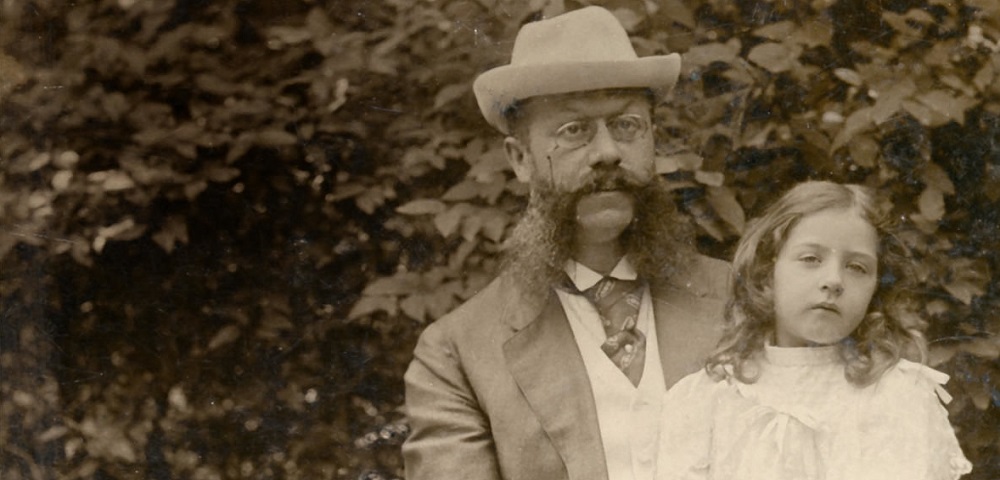
The “Mercedes” part of Mercedes-Benz was named after Emil Jellinek’s daughter Mercedes in 1901.
Emil Jellinek was an automobile entrepreneur at the time who worked with the company.
June 27 ,2018
Emil Jellinek was born in Leipzig on April 6, 1853. He gave his parents little joy during his school years he was given private lessons for several years, and later no school could keep him for long. Emil Jellinek resisted any compulsion to learn. At the age of 17 he was employed as an official by the North-West Rotkosteletz railway company, but left this employment only two years later. Emil Jellinek now made his way to France, and was then called to Tangiers by the Austro-Hungarian Consul. One year later he went to Tetuan as a consular agent, married a French woman and established himself as a successful trader in North African products.
In 1881 Jellinek returned to Vienna, where he managed the agency of an insurance company and became an inspector. He then followed the call to North Africa again, and his two sons Adolph and Fernand were born in Algiers. In 1889 Emil Jellinek returned to live in Vienna with his family.
Mercedes Jellinek
Emil Jellinek's business dealings were so profitable that he moved to Nice, where he bought his first vehicle: a De Dion-Bouton tricycle. This was followed by a three-wheel Léon-Bollée Voiturette and then a four-seater Benz carriage. A newspaper article drew Jellinek's attention to Daimler-Motoren-Gesellschaft (DMG). In 1897, he travelled to Cannstatt to visit the Daimler factory and ordered his first Daimler car: a 6 hp belt-driven model with a 2-cylinder engine. The car with a top speed of 24 km/h delivered in October 1897 soon proved too slow for Jellinek. He asked for a top speed of 40 km/h and ordered two further vehicles. The two Daimler 'Phoenix' cars with front-mounted 8 hp engine delivered in September 1898 were the world's first road-going vehicles to feature a four-cylinder engine.
Emil Jellinek, who had a large house in Nice and maintained good relationships with the international finance world and aristocracy, also increased his car-dealing activities from 1898 onwards: he promoted and sold the Daimler vehicles in the highest echelons of society. DMG supplied Jellinek with 10 vehicles as early as 1899. Emil Jellinek asked DMG for increasingly powerful and fast vehicles and also entered races with them – most notably the Nice Race Week – where he appeared under a pseudonym: he used his daughter's first name. The successes he achieved meant that the name 'Mercedes' was already on everybody's lips in motoring circles, even back then.
In April 1900 the pseudonym 'Mercedes' became a product name. Jellinek and DMG concluded an agreement covering the sale of vehicles and engines, also agreeing to develop a new form of engine which would bear 'the name Daimler-Mercedes'. About two weeks later Jellinek ordered 36 vehicles for a total price of 550,000 Marks – roughly three million euros according to today’s value. This was a very large order by any standards. A few weeks later he ordered a further 36 vehicles, all with eight-horsepower engines. On December 22, 1900, DMG delivered the first car equipped with the new engine to Jellinek, a 35 hp racing car. This first Mercedes, which was developed by DMG’s Chief Engineer Wilhelm Maybach, caused a sensation as the new century began. With its low centre of gravity, pressed steel frame, lightweight yet powerful engine and honeycomb radiator it is now acknowledged as the first modern automobile. The Nice Week in March 1901, during which the Mercedes racing cars proved practically unbeatable in almost every discipline, helped to make Jellinek and the brand name extremely well-known. The 12/16 hp and 8/11 hp sister models appeared in March and August 1901. Thanks to Jellinek’s further orders, the production capacity of the Daimler factory in Cannstatt was stretched to the limit.
'Mercedes' as a brand name :
On June 23, 1902 'Mercedes' was registered as a brand name, and legally protected on September 26. In June 1903 Emil Jellinek obtained permission to call himself Jellinek-Mercedes in future. 'This is probably the first time a father has borne the name of his daughter,' the successful businessman remarked at the time. In 1907 Jellinek was appointed Austro-Hungarian Consul General, becoming Mexican Consul shortly afterwards. In 1909 Jellinek withdrew from the automotive business and devoted himself to his duties as head of the Austro-Hungarian consulate in Monaco. Until his death on January 21, 1918 Emil Jellinek remained an interested observer of automotive engineering.